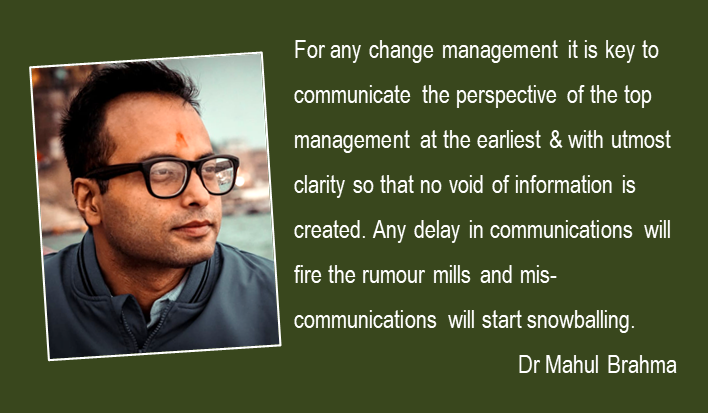Change is the only constant. There are some changes that impact an organisation locally and some that impact globally. We will be discussing the latter. When organisations talk about change management they refer to the one that impacts every stakeholder – internal as well as external.
Some examples of change:
- New management – impacts internal as well as external stakeholders
- Merger or acquisition – impacting internal stakeholders more in terms of adapting to the new culture
- Conversion towards High Performance Organisation – for internal stakeholders directly impacting performance measures
- Move towards leaner organisation – for internal stakeholders directly impacting job
- Move towards new brand positioning – impacts both internal and external stakeholders
Why strategic communication? In case of change management it is important to do two things – segment the communication in phases and then divide the audience into segments and create tailored communication targeting the segments across the phases. Strategic communication is the only tool that has the potential to reach out to every stakeholder, internal and external.
For any change management it is key to communicate the perspective of the top management with utmost clarity at the earliest so that no void of information is created. Any delay in communications will fire the rumour mills and miscommunications will start snowballing. This is a time when change turns into a crisis.
It is very important that the first communication informing the change needs to come directly from the top boss — MD/CEO/Chairman. The first communication has to come from the top otherwise the gravity of the transformation is lost. So the first step in strategic communication is organising such an opportunity wherein the decision maker is given a platform to reach out to internal stakeholders directly.
The strategic objective of this communication is to establish the raison-d’etre for change.
The first communication has the power to make every internal stakeholder responsible and key for the change – co-creating the change.
Transparency is the key. There are occasions when it is seen that employees have found out about strategic changes via news reports or from their friends outside the organisation. This is a recipe for disaster. An organisation will end up alienating key stakeholders and your change will never be effective.
Communication strategy has to be an inverted pyramid. We consider the pyramid to be in terms of hierarchy – top, senior, middle and junior management. With the bottom of the pyramid addressed first and then once an organisation has their buy-in it helps pave the foundation for the change to be internalised by the entire company.
The subsequent communications, internal and external, have to be targeted.
Key challenges for change management come from stakeholders – both internal and external. They may not be in agreement with the change. And honestly, no one likes change. Change is uncertain and the stakeholders may feel insecure with the change, there is also the issue of relevance, especially with internal stakeholders. For example, if the change entails a greater degree of automation or a greater intervention of Artificial Intelligence or Machine Learning as a strategic objective, people will fear loss of jobs. It is natural. So any change is bound to face obstacles. So it is the responsibility of the top management through strategic and transparent communication to explain that without this change the company is likely to become obsolete and shut down. It is only then the real buy-in comes.
So, the first step for any change management is the buy-in from stakeholders. The management needs to convince the internal stakeholders the benefit for the organisation from the change and then how that benefit will translate into benefit of internal stakeholders. For example, when a company shuts down stores it is perceived only to be a bad news. However, you can also choose to look at it this way that the company is actually stopping its loss and making its existence viable for the existing employees as well as shareholders. It is a matter of perception. That is the job of communication to create the right optics.
Any strategic change that impacts all stakeholders across all levels will fail to meet its strategic objective if stakeholders fail to understand the need for change and therefore are not aligned to it. Therefore, without the alignment of the organisation, especially the internal stakeholders, no change can be effective. So effectiveness is an outcome of the degree of alignment of the stakeholders, especially internal. Ineffective communication will always result in lack of alignment and thus the outcome will be clear with the organisation not able to meet its strategic objective.
Thus the effectiveness of the communication is measured by the effectiveness of the change management. Strategic communication is the key but never forget it is a means not an end. So the measure of its success has to be the success of the change management and the effectiveness with which it is managed across all the phases. So every phase milestone will have a strategic communication milestone attached to it and this is how the journey takes place towards change management.
Strategic communication is the key to effective change management.
The views and opinions published here belong to the author and do not necessarily reflect the views and opinions of the publisher.



Be the first to comment on "How to use strategic communication in change management"